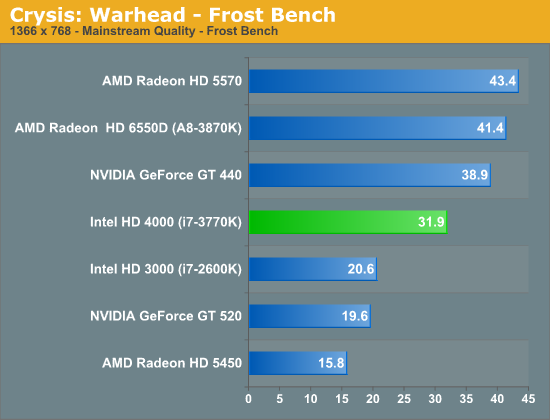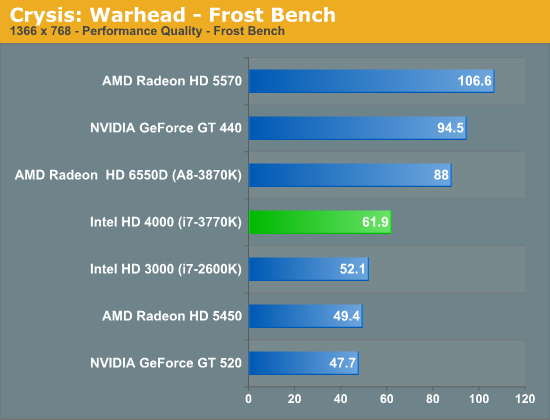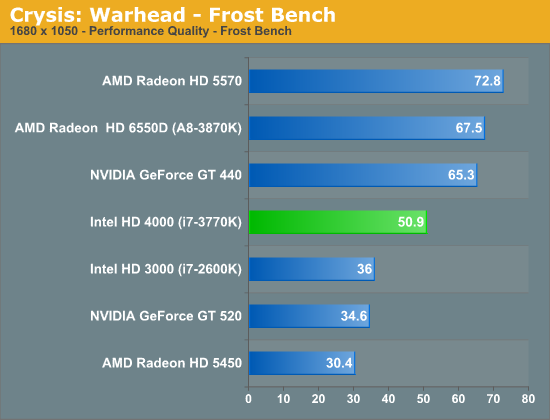The Ivy Bridge Preview: Core i7 3770K Tested
by Anand Lal Shimpi on March 6, 2012 8:16 PM EST- Posted in
- CPUs
- Intel
- Core i7
- Ivy Bridge
Intel HD Graphics 4000 Performance
With respectable but still very tick-like performance gains on the CPU, our focus now turns to Ivy Bridge's GPU. Drivers play a significant role in performance here and we're still several weeks away from launch so these numbers may improve. We used the latest available drivers as of today for all other GPUs.
A huge thanks goes out to EVGA for providing us with a GeForce GT 440 and GeForce GT 520 for use in this preview.
Crysis: Warhead
We'll start with Crysis, a title that no one would have considered running on integrated graphics a few years ago. Sandy Bridge brought playable performance at low quality settings (Performance defaults) last year, but how much better does Ivy do this year?

In our highest quality benchmark (Mainstream) settings, Intel's HD Graphics 4000 is 55% faster than the 3000 series graphics in Sandy Bridge. While still tangibly slower than AMD's Llano (Radeon HD 6550D), Ivy Bridge is a significant step forward. Drop the quality down a bit and playability improves significantly:


Over 50 fps at 1680 x 1050 from Intel integrated graphics is pretty impressive. Here we're showing a 41% increase in performance compared to Sandy Bridge, with Llano maintaining a 33% advantage over Ivy. I would've liked to have seen an outright doubling of performance, but this is a big enough step forward to be noticeable on systems with no discrete GPU.











195 Comments
View All Comments
niva - Wednesday, March 7, 2012 - link
I think it's a long time away from approaching 560m performance. If you're going to do any remotely serious gaming on a laptop it's still best to get a dedicated graphics card.I'm still sticking to gaming on a tower, so these CPUs (esp the AMD llano) make sense for me in laptops. Don't ever see myself gaming on a laptop unless I completely get rid of the towers in my house... which won't happen anytime soon (if ever.)
pepperoni - Wednesday, March 7, 2012 - link
I felt the same way when I was shopping recently. I WANTED to buy a Llano-based notebook (inexpensive, better graphics vs. Intel). The problem is there's no such thing as a slim and light Llano. Every OEM sticks you with the same configuration: six pounds and 15.6" turd-768 resolution screen. It's bizarre.For the sake of competition, I hope Trinity will get some better design wins.
CeriseCogburn - Sunday, January 27, 2013 - link
If you look at the gaming charts, the resolution may go past x768, but the settings are on LOW, and don't give us a minimum frame rate, so the answer is:That's all that llano can handle is low end low rez.
So AMD forces the giant .lb weighted monster as a selling point.
poached - Wednesday, April 18, 2012 - link
so AMD?Demon-Xanth - Wednesday, March 7, 2012 - link
I agree with you there. To get those "$100 mid range GPUs" on a laptop you need to bump up the cost by around $400 to get to one that simply can have one. Most laptops currently do not have discrete GPUs.I am glad to see that integrated graphics from both Intel and AMD can now be compared with low end cards like the GT520 and GT440 without it becoming a laugh. Also that they are actually completing the tests well now. That is a rather major step. I remember some reviews of integrated graphics that resulted in a lot of either "could not complete" or "the bar is too small to fit a number on" entries.
Azethoth - Wednesday, March 7, 2012 - link
The IGP provides the QuickSync implementation. It would be insane to not include the silicon for it on the high end system. In addition moving forward you can get compute work out of the GPU so why would you ever not include it.danjw - Wednesday, March 7, 2012 - link
Quicksync the Intel video transcoding feature is based in the GPU. This is important to a lot of users.sweetspot - Wednesday, March 7, 2012 - link
Well also these make for nice office machines. So businesses upgrading there desktop workstations.When you have thousands of employees, the desktop refresh, these are decent option, since they are not gaming at work ( right lol ).
Taft12 - Sunday, March 18, 2012 - link
Hardly any large corporations buy desktops anymore. Maybe for the call centre employees, that's about it.AFUMCBill - Wednesday, March 7, 2012 - link
Because gaming isn't the only thing that uses graphics cards. For instance, more and more video editors use the graphics card for doing video decode/encode/applying effects. So having a high performance graphics engine to go along with the high performance CPU can be a really nice thing.